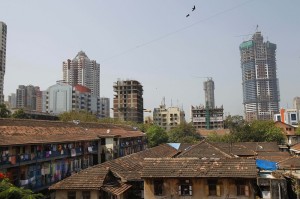China, India skyscraper boom may herald downturn

In this Oct. 31, 2011, file photo, high-rise buildings are seen behind old low-rise ones in Mumbai, India. A skyscraper building boom in China and India may be a sign of an impending economic correction in two of Asia's largest economies, according to a new report by Barclays Capital. AP PHOTO/RAFIQ MAQBOOL
MUMBAI, India—A skyscraper building boom in China and India may signal an impending economic correction in two of Asia’s largest economies, a new report says.
Barclays Capital has mapped an “unhealthy correlation” between construction of the world’s tallest buildings and impending financial crises over the last 140 years.
Today, China is home to half of the world’s skyscrapers—defined as buildings over 240 meters (787 feet) tall—currently under construction.
India, which has just two skyscrapers, is seeing its first skyscraper building boom, with 14 under construction, including the world’s second-tallest tower, in the financial capital Mumbai.
“Building booms are a sign of excess credit,” Andrew Lawrence, director of property research at Barclays Capital in Hong Kong, said Wednesday.
Historically, skyscraper construction has been characterized by bursts of sporadic, but intense activity that coincide with easy credit, rising land prices and excessive optimism, but often by the time skyscrapers are finished, the economy has slipped into recession, Lawrence said.
The Great Depression hit as the finishing touches were being put on three record-breaking buildings in New York: 40 Wall Street, the Chrysler Building and the Empire State Building, which were all completed between 1929 and 1931, Barclays noted in a January 10 report.
The economic and oil crises of the 1970s coincided with the completion of the twin towers at New York’s World Trade Center, in 1972 and 1973, and Chicago’s Sears Tower in 1974.
The Asian financial crisis hit as Kuala Lumpur’s Petronas Towers were finished in 1997.
Dubai’s $4.1 billion Burj Khalifa, completed in 2010, is now the world’s tallest building. As it was being built, Dubai nearly went bust and the world slid into the Great Recession.
“Thankfully for the world economy, there is not currently a skyscraper under construction that is planned to overtake the height of the Burj Khalifa,” the report said.
However, signs of trouble are escalating in China and India.
Today, China gets the dubious distinction of being the world’s “biggest bubble builder,” as it erects ever more and ever higher towers, Barclays said. Home to 53 percent of the 124 skyscrapers now under construction globally, China is primed to increase its stock of skyscrapers by 87 percent.
About 80 percent of new buildings are going up in tier two and three cities, away from developed coastal areas of the Pearl River Delta and Yangtze River Delta, which Barclays called “evidence of the expanding building bubble.”
Lawrence, who was lead author of the report, said China’s property market is already wobbling.
The number of residential property sales has decreased 40 to 50 percent in Beijing and Shanghai and developers have slashed prices 5 to 20 percent, he said.
India, which has just two skyscrapers but is building 14 more, takes top honors for hubris: The second tallest building in the world, the Tower of India, is now under construction in Mumbai.
Nonperforming loans in India—a substantial number of them to real estate ventures—grew by nearly a third in the first half of this fiscal year, more than triple the average annual growth rate since 2006, according to the Reserve Bank of India.
“If history proves to be right, this building boom in India and China could simply be a reflection of a misallocation of capital, which may result in an economic correction for two of Asia’s largest economies in the next five years,” Barclays said.